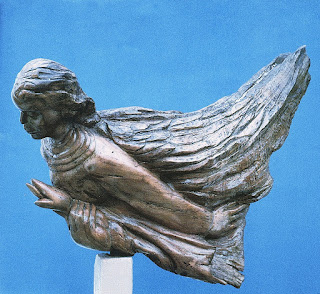Dr. Selma Burke
 |
| Selma Burke (1900-1995) with the engraving of Franklin Delano Roosevelt, 1945, U. S. National Museum of the U.S. Navy Archive. |
Dr. Selma Hortense Burke was born on December 31, 1900 in Mooresville, North Carolina, the seventh of ten children in a strong religion household.
In African American Art and Artists, a book by Dr. Samella Lewis (also a well-known artist, historian, author, art collector, and former educator), Burke reflected on the moment art caught her attention.
"It was there in 1907 that I discovered me," Burke said, recalling the experience of digging out clay on her parents' farm and squeezing it in her hands.
Thus, a woman encouraged to go into nursing by her parents decided that art was a more significant calling. She completed studies at Winston-Salem State School, St Agnes Training School for Nurses in Raleigh, North Carolina, and Columbia University in New York City. Although she worked as a nurse for a while, the art never left her being. The twice married artist had a stormy relationship with poet Claude McKay who destroyed her work from time to time (a whole other story) if it did not meet his satisfaction. Simultaneously, Dr. Burke involved herself with the Works Progress Administration and New Deal Federal Workers Project. She eventually received the prestigious Rosenwald Grant (a huge award given to a lot of promising Black artists), traveling to Europe (Vienna and Paris) and studying with the likes of Aristide Maillol and Henri Matisse.
Dr. Burke's legacy is founded on the incredible marksmanship and phenomenal quality expressed in the body of classically rendered sculpture she left behind— mostly at Spelman College, which also has her archives. Comprised out of various woods, bronze, plaster, Dr. Burke’s masterful busts and reliefs (mostly of Black bodies) are impressively rendered, evocative, richly detailed, and command attention, authority. Beyond the Roosevelt dime controversy, Dr. Burke is known for her portraits of Booker T. Washington, religious works Temptation and Fallen Angel, and a nine-foot statue of Martin Luther King Jr. in Charlotte, North Carolina.
 |
| Untitled (Woman With Child), painted red oak, 47 1/8" x 12 3/4" x 11 3/4," 1950, Smithsonian American Art Museum. |
 |
| Booker T. Washington., patined plaster, Artstor, Artstor, library.artstor.org/asset/ARTSTOR_103_41822000282549 (wrongly titled Mr. Johnson). |
 |
| Fallen Angel, pearwood, 78" x 32" x 15," 1958. Artstor., library.artstor.org/asset/ARTSTOR_103_41822000282556 |
 |
| Charlotte Hawkins Brown, bronze, 9," Telane University, Amistad Research Center, Artstor, library.artstor.org/asset/AWSS35953_35953_33064397 |
Over the years, Dr. Burke won countless honors including honorary doctorates, a lifetime achievement award from the National Women’s Caucus for Art, the Pearl S. Buck Foundation’s Women’s Award, and the Candace Award from the National Coalition of 100 Black Women.
Yet it was the Roosevelt dine that haunted her career— a moment that started with a series of sketches from a 45 minute Roosevelt sitting session and the bas relief sculpture that would start it all.
 |
| Selma Burke in her studio, Carnegie Museum of Art Archive. |
"In 1943, Dr. Burke won the District of Columbia Fine Arts Commission competition for her bronze plaque of President Roosevelt. Today, this plaque hangs in the Recorder of Deeds Office here in Washington, DC, and according to scholars, is the basis for the image of President Franklin D. Roosevelt which appears on the United States dime.
'I'm so mad at that man,' Dr. Burke says of John Sinnock (the former mint chief engraver who, according to Burke, copied a bronze portrait plaque of Roosevelt created by Burke in 1944 for the Recorder of Deeds Office). Officials at the mint say their records show Sinnock deserves full credit for the Roosevelt dime. But Burke isn't convinced. She says that because she is black, she will never get the recognition she feels she deserves. `This has happened to so many black people. I have never stopped fighting this man and have never had anyone who cared enough to give me the credit.'
At the time of her death on August 29, 1995 at age 94 in New Hope, Pennsylvania, she held many honors and awards, inspired new generations of up and coming artists, and left behind a beloved dog E. D.
 |
| Dr. Selma Burke in her studio circa 1990's in New York City, Adger Cowans/Getty |





Comments
Post a Comment